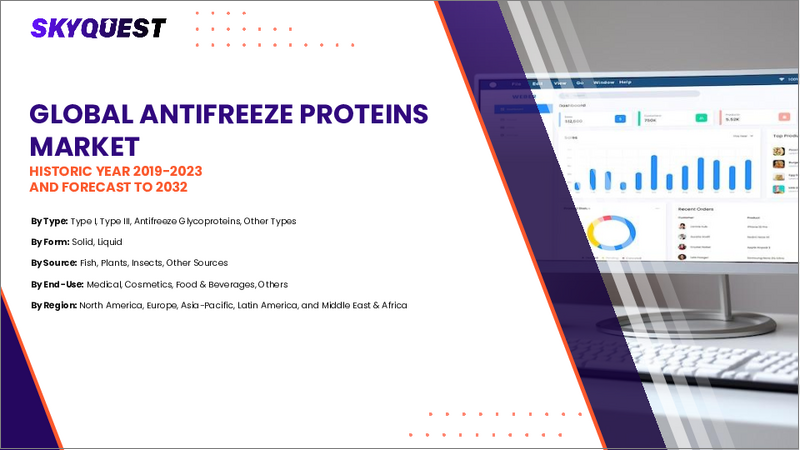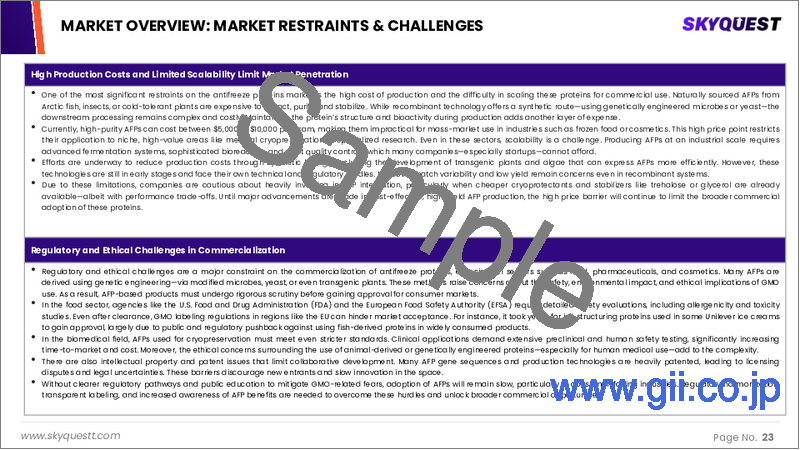|
|
市場調査レポート
商品コード
1673795
不凍タンパク質の市場規模、シェア、成長分析:タイプ別、形態別、供給源別、最終用途別、地域別 - 産業予測 2025~2032年Antifreeze Proteins Market Size, Share, and Growth Analysis, By Type (Type I, Type III), By Form (Solid, Liquid), By Source, By End use, By Region - Industry Forecast 2025-2032 |
||||||
|
|||||||
| 不凍タンパク質の市場規模、シェア、成長分析:タイプ別、形態別、供給源別、最終用途別、地域別 - 産業予測 2025~2032年 |
|
出版日: 2025年03月03日
発行: SkyQuest
ページ情報: 英文 198 Pages
納期: 3~5営業日
|
全表示
- 概要
- 目次
不凍タンパク質の市場規模は2023年に1,270万米ドルで、2024年の1,671万米ドルから2032年には1億5,035万米ドルに拡大し、予測期間中(2025-2032年)のCAGRは31.6%で成長する見通しです。
冷凍食品市場は、タンパク質が豊富な食品や飲食品に対する消費者の需要が世界的に高まっていることを背景に、予測期間中に大きく成長するとみられます。さらに、スキンケア製品、特にアンチエイジングクリームへの人工タンパク質の応用が増加していることが、市場拡大にさらに拍車をかけています。特筆すべきは、燻製魚や手頃な価格のオーガニック・サーモンのような高品質の冷凍製品に焦点を当てたノルウェーの養殖部門からの投資も市場を活性化していることです。オーロラサーモンに対する英国の食欲の高まりもこの動向に寄与しています。冷凍手術技術の向上と、収穫時期の延長を後押しする養殖方法の改善が、食品業界の売上を牽引します。さらに、生物活性特性で知られる不凍タンパク質の製薬分野での採用は、米国不凍タンパク質市場の有望な軌道に道を開き、大きな成長機会となります。
目次
イントロダクション
- 調査の目的
- 調査範囲
- 定義
調査手法
- 情報調達
- 二次と一次データの方法
- 市場規模予測
- 市場の前提条件と制限
エグゼクティブサマリー
- 世界市場の見通し
- 供給と需要の動向分析
- セグメント別機会分析
市場力学と見通し
- 市場概要
- 市場規模
- 市場力学
- 促進要因と機会
- 抑制要因と課題
- ポーターの分析
主な市場の考察
- 重要成功要因
- 競合の程度
- 主な投資機会
- 市場エコシステム
- 市場の魅力指数(2024年)
- PESTEL分析
- マクロ経済指標
- バリューチェーン分析
- 価格分析
- 規制情勢
- ケーススタディ
- 技術の進歩
不凍タンパク質市場規模:タイプ別& CAGR(2025-2032)
- 市場概要
- タイプI
- タイプIII
- 不凍糖タンパク質
- その他のタイプ
不凍タンパク質市場規模:形態別& CAGR(2025-2032)
- 市場概要
- 固体
- 液体
不凍タンパク質市場規模:供給源別& CAGR(2025-2032)
- 市場概要
- 魚
- 植物
- 昆虫
- その他の供給源
不凍タンパク質市場規模:最終用途別& CAGR(2025-2032)
- 市場概要
- 医療
- 化粧品
- 食品
- その他
不凍タンパク質市場規模:地域別& CAGR(2025-2032)
- 北米
- 米国
- カナダ
- 欧州
- ドイツ
- スペイン
- フランス
- 英国
- イタリア
- その他欧州地域
- アジア太平洋地域
- 中国
- インド
- 日本
- 韓国
- その他アジア太平洋地域
- ラテンアメリカ
- ブラジル
- その他ラテンアメリカ地域
- 中東・アフリカ
- GCC諸国
- 南アフリカ
- その他中東・アフリカ
競合情報
- 上位5社の比較
- 主要企業の市場ポジショニング(2024年)
- 主な市場企業が採用した戦略
- 最近の市場動向
- 企業の市場シェア分析(2024年)
- 主要企業の企業プロファイル
- 企業の詳細
- 製品ポートフォリオ分析
- 企業のセグメント別シェア分析
- 収益の前年比比較(2022-2024)
主要企業プロファイル
- Nichirei Corporation.(Japan)
- Kaneka Corporation(Japan)
- A/F Protein Inc.(US)
- Sirona Biochem(Canada)
- Unilever(Netherlands)
- ProtoKinetix, Inc.(US)
- Shanghai Yu Tao Industrial Co., Ltd.(China)
- Kodera Herb Garden Co., Ltd(Japan)
- Beijing Huacheng Jinke Technology Co., Ltd.(China)
- Rishon Biochem Co., Ltd(China)
- MyBiosource, Inc.(US)
- Antifreeze Protein Technologies, Inc.(USA)
- Cytograft Tissue Engineering, Inc.(USA)
- Thermotolerant Protein Solutions Ltd.(UK)
結論と提言
Antifreeze Proteins Market size was valued at USD 12.7 million in 2023 and is poised to grow from USD 16.71 million in 2024 to USD 150.35 million by 2032, growing at a CAGR of 31.6% during the forecast period (2025-2032).
The frozen meals market is set for significant growth during the forecast period, driven by rising consumer demand for protein-rich food and beverages globally. Additionally, the increasing application of engineered proteins in skincare products, particularly anti-aging creams, is further fueling market expansion. Notably, investments from Norway's aquaculture sector focusing on high-quality frozen products, like smoked fish and affordable organic salmon, are also revitalizing the market. The UK's growing appetite for aurora salmon contributes to this trend. Enhanced cryosurgery techniques and improved aquaculture practices bolstering extended harvest seasons will drive food industry sales. Moreover, the pharmaceutical sector's adoption of antifreeze proteins, known for their bioactive properties, presents substantial growth opportunities, paving the way for a promising trajectory in the US antifreeze proteins market.
Top-down and bottom-up approaches were used to estimate and validate the size of the Antifreeze Proteins market and to estimate the size of various other dependent submarkets. The research methodology used to estimate the market size includes the following details: The key players in the market were identified through secondary research, and their market shares in the respective regions were determined through primary and secondary research. This entire procedure includes the study of the annual and financial reports of the top market players and extensive interviews for key insights from industry leaders such as CEOs, VPs, directors, and marketing executives. All percentage shares split, and breakdowns were determined using secondary sources and verified through Primary sources. All possible parameters that affect the markets covered in this research study have been accounted for, viewed in extensive detail, verified through primary research, and analyzed to get the final quantitative and qualitative data.
Antifreeze Proteins Market Segments Analysis
Global Antifreeze Proteins Market is segmented by Type, Form, Source, End use and region. Based on Type, the market is segmented into Type I, Type III, Antifreeze Glycoproteins and Other Types. Based on Form, the market is segmented into Solid and Liquid. Based on Source, the market is segmented into Fish, Plants, Insects and Other sources. Based on End use, the market is segmented into Medical, Cosmetics, Food and Others. Based on region, the market is segmented into North America, Europe, Asia Pacific, Latin America and Middle East & Africa.
Driver of the Antifreeze Proteins Market
The Antifreeze Proteins market is experiencing significant growth due to their diverse applications across several sectors, including food, cosmetics, healthcare, and agriculture. As industries increasingly recognize the benefits of antifreeze proteins-such as their capability to enhance product preservation and improve safety-the demand for these proteins continues to rise. This surge in interest is propelling market expansion, as companies seek innovative solutions to meet consumer needs. The versatility of antifreeze proteins allows them to play a crucial role in various applications, contributing to their widespread adoption and further stimulating market development.
Restraints in the Antifreeze Proteins Market
The antifreeze proteins market faces significant challenges due to the complex and costly production processes involved in manufacturing these proteins. This complexity not only increases production costs but also makes them less economically viable when compared to various other protein types. Consequently, the higher price point of antifreeze proteins can limit their adoption and integration across different applications. As a result, this economic barrier serves as a constraint for market growth, potentially hindering advancements and innovations that could otherwise drive demand and broaden the scope of antifreeze proteins in various industries.
Market Trends of the Antifreeze Proteins Market
The Antifreeze Proteins market is witnessing a notable upward trend, driven primarily by rising demand from the food industry, where these proteins are utilized to enhance the quality and extend the shelf-life of frozen products. As food manufacturers increasingly prioritize product quality and consumer satisfaction, the adoption of antifreeze proteins is expected to grow significantly. This trend is supported by advancements in biotechnology, which are enabling the production of more efficient and effective antifreeze proteins. Additionally, growing awareness of food preservation techniques and clean-label trends are further contributing to the market's expansion, setting the stage for sustained growth in the coming years.
Table of Contents
Introduction
- Objectives of the Study
- Scope of the Report
- Definitions
Research Methodology
- Information Procurement
- Secondary & Primary Data Methods
- Market Size Estimation
- Market Assumptions & Limitations
Executive Summary
- Global Market Outlook
- Supply & Demand Trend Analysis
- Segmental Opportunity Analysis
Market Dynamics & Outlook
- Market Overview
- Market Size
- Market Dynamics
- Drivers & Opportunities
- Restraints & Challenges
- Porters Analysis
- Competitive rivalry
- Threat of substitute
- Bargaining power of buyers
- Threat of new entrants
- Bargaining power of suppliers
Key Market Insights
- Key Success Factors
- Degree of Competition
- Top Investment Pockets
- Market Ecosystem
- Market Attractiveness Index, 2024
- PESTEL Analysis
- Macro-Economic Indicators
- Value Chain Analysis
- Pricing Analysis
- Regulatory Landscape
- Case Studies
- Technological Advancement
Global Antifreeze Proteins Market Size by Type & CAGR (2025-2032)
- Market Overview
- Type I
- Type III
- Antifreeze Glycoproteins
- Other Types
Global Antifreeze Proteins Market Size by Form & CAGR (2025-2032)
- Market Overview
- Solid
- Liquid
Global Antifreeze Proteins Market Size by Source & CAGR (2025-2032)
- Market Overview
- Fish
- Plants
- Insects
- Other sources
Global Antifreeze Proteins Market Size by End use & CAGR (2025-2032)
- Market Overview
- Medical
- Cosmetics
- Food
- Others
Global Antifreeze Proteins Market Size & CAGR (2025-2032)
- North America (Type, Form, Source, End use)
- US
- Canada
- Europe (Type, Form, Source, End use)
- Germany
- Spain
- France
- UK
- Italy
- Rest of Europe
- Asia Pacific (Type, Form, Source, End use)
- China
- India
- Japan
- South Korea
- Rest of Asia-Pacific
- Latin America (Type, Form, Source, End use)
- Brazil
- Rest of Latin America
- Middle East & Africa (Type, Form, Source, End use)
- GCC Countries
- South Africa
- Rest of Middle East & Africa
Competitive Intelligence
- Top 5 Player Comparison
- Market Positioning of Key Players, 2024
- Strategies Adopted by Key Market Players
- Recent Developments in the Market
- Company Market Share Analysis, 2024
- Company Profiles of All Key Players
- Company Details
- Product Portfolio Analysis
- Company's Segmental Share Analysis
- Revenue Y-O-Y Comparison (2022-2024)
Key Company Profiles
- Nichirei Corporation. (Japan)
- Company Overview
- Business Segment Overview
- Financial Updates
- Key Developments
- Kaneka Corporation (Japan)
- Company Overview
- Business Segment Overview
- Financial Updates
- Key Developments
- A/F Protein Inc. (US)
- Company Overview
- Business Segment Overview
- Financial Updates
- Key Developments
- Sirona Biochem (Canada)
- Company Overview
- Business Segment Overview
- Financial Updates
- Key Developments
- Unilever (Netherlands)
- Company Overview
- Business Segment Overview
- Financial Updates
- Key Developments
- ProtoKinetix, Inc. (US)
- Company Overview
- Business Segment Overview
- Financial Updates
- Key Developments
- Shanghai Yu Tao Industrial Co., Ltd. (China)
- Company Overview
- Business Segment Overview
- Financial Updates
- Key Developments
- Kodera Herb Garden Co., Ltd (Japan)
- Company Overview
- Business Segment Overview
- Financial Updates
- Key Developments
- Beijing Huacheng Jinke Technology Co., Ltd. (China)
- Company Overview
- Business Segment Overview
- Financial Updates
- Key Developments
- Rishon Biochem Co., Ltd (China)
- Company Overview
- Business Segment Overview
- Financial Updates
- Key Developments
- MyBiosource, Inc. (US)
- Company Overview
- Business Segment Overview
- Financial Updates
- Key Developments
- Antifreeze Protein Technologies, Inc. (USA)
- Company Overview
- Business Segment Overview
- Financial Updates
- Key Developments
- Cytograft Tissue Engineering, Inc. (USA)
- Company Overview
- Business Segment Overview
- Financial Updates
- Key Developments
- Thermotolerant Protein Solutions Ltd. (UK)
- Company Overview
- Business Segment Overview
- Financial Updates
- Key Developments





